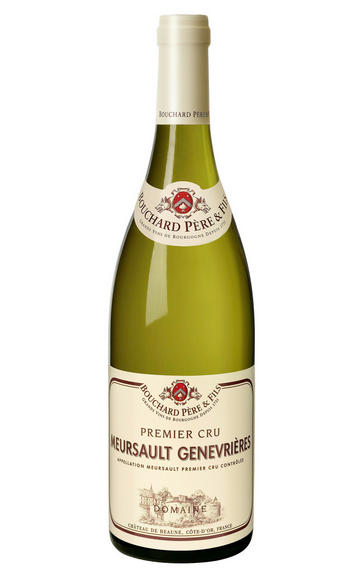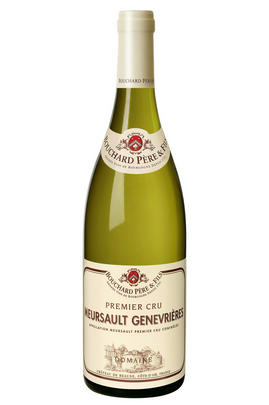
2019 Meursault, Genevrières, 1er Cru, Domaine Bouchard Père & Fils, Burgundy

Critics reviews
Jasper Morris MW, insideburgundy.com (December 2020)
About this WINE

Bouchard Pere et Fils
The Burgundian wine domaine of Bouchard Pére et Fils can trace its origins back to 1731 though it is no longer family owned. In 1995 the Champagne house, Joseph Henriot, acquired the company and quality has risen as a consequence.
Today Bouchard is led by Stéphane Follin Arbelet while the wines are made by Philippe Prost who has been with the company since 1978. An impressive gravity-flow winery on the Route de Savigny, the Cuvérie St Vincent, was completed in 2005, enabling them, to process all their wines with optimum efficiency.
Bouchard’s total holdings comprise 130 hectares, including 12ha of grand crus and 74ha of premier crus, which makes them the largest vineyard owners in the Côte d’Or (Côte de Nuits and Côte de Beaune).
Bouchard have good holdings in the village of Monthélie, which lies just beyond Volnay and looks down over Meursault. The village is best known for its red wines, a little firmer in structure than Volnay and of particular interest in perfect summers when the grapes can ripen fully.

Meursault
There are more top producers in Meursault than in any other commune of the Côte d’Or. Certainly it is the most famous and popular of the great white appellations. Its wines are typically rich and savoury with nutty, honeyed hints and buttery, vanilla spice from the oak.
Even though it is considerably larger than its southerly neighbours Chassagne and Puligny, Meursault contains no Grands Crus. Its three best Premiers Crus, however – Les Perrières, Les Genevrières and Les Charmes – produce some of the region’s greatest whites: they are full, round and powerful, and age very well. Les Perrières in particular can produce wines of Grand Cru quality, a fact that is often reflected in its price. Meursault has also been one of the driving forces of biodynamic viticulture in the region, as pioneered by Lafon and Leflaive.Many of the vineyards below Premier Cru, known as ‘village’ wines, are also well worth looking at. The growers vinify their different vineyard holdings separately, which rarely happens in Puligny or Chassagne. Such wines can be labelled with the ‘lieu-dit’ vineyard alongside (although in smaller type to) the Meursault name.
Premier Cru Meursault should be enjoyed from five to 15 years of age, although top examples can last even longer. Village wines, meanwhile, are normally at their best from three to 10 years.
Very occasionally, red Meursault is produced with some fine, firm results. The best red Pinot Noir terroir, Les Santenots, is afforded the courtesy title of Volnay Santenots, even though it is actually in Meursault.
- 305 hectares of village Meursault. The best vineyards include Clos de la Barre, Tesson, Chevalières, Rougeot, Narvaux
- 132 hectares of Premier Cru vineyards (17 in all). The finest vineyards include Les Perrières, Les Genevrières and Les Charmes
- Recommended producers: Comte Lafon, Arnaud Ente, Coche Dury, Guy Roulot, Jean-Philippe Fichet, Patrick Javillier, François Jobard, Michel Bouzereau
- Recommended restaurant: Le Chevreuil

Chardonnay
Chardonnay is often seen as the king of white wine grapes and one of the most widely planted in the world It is suited to a wide variety of soils, though it excels in soils with a high limestone content as found in Champagne, Chablis, and the Côte D`Or.
Burgundy is Chardonnay's spiritual home and the best White Burgundies are dry, rich, honeyed wines with marvellous poise, elegance and balance. They are unquestionably the finest dry white wines in the world. Chardonnay plays a crucial role in the Champagne blend, providing structure and finesse, and is the sole grape in Blanc de Blancs.
It is quantitatively important in California and Australia, is widely planted in Chile and South Africa, and is the second most widely planted grape in New Zealand. In warm climates Chardonnay has a tendency to develop very high sugar levels during the final stages of ripening and this can occur at the expense of acidity. Late picking is a common problem and can result in blowsy and flabby wines that lack structure and definition.
Recently in the New World, we have seen a move towards more elegant, better- balanced and less oak-driven Chardonnays, and this is to be welcomed.


Buying options
Add to wishlist
Description
This cuvée is from two parcels in the upper section of Genevrières, covering a total of 2.65 hectares. Genevrières will often display rich, nutty and honey notes, and a marked citrus aspect. Qualitatively, the best examples can rival neighbouring Perrières. Estimated 2024-2035 (Not Tasted)
wine at a glance
Delivery and quality guarantee